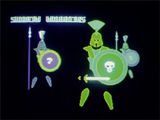Dreamware
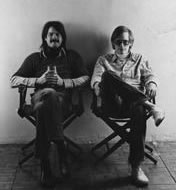
These were some early software concepts that The Communication Studio prototyped, but never fully marketed during the "first wave" of interactivity in the early-to-mid 80's.
Some of the concepts were kind of forward-looking.
John Vaughan and Bill Porter in the loft (1983)
Phoenix (1986)
Smart Art
Purpose:
Screen Designer featuring Automated Field Labeling. This was to be the "next step" for the TextUp suite of productivity tools. Pretty sweet - especially this early on the curve.
PHOENIX is a graphics screen creation system that allows you to dynamically add metadata tags to the design elements as you create a page. Features include:
Iconic Menus can be relocated anywhere on the screen.
Automated "One-Step" Metadata Field Labelling
Enter Customized Text Font (using TCS Text Font Library)
Merge Clip Art File
On-Screen Text Formatting and Entry
"Elemental Design" editing controls
Full range of NAPLPS drawing and animation capabiliies
Store output as Bitmap or NAPLPS Vectorgraphics
As far as I can tell, PHOENIX was one of the first screen-design tools to offer integrated information tagging as one of the design features.
It allowed you to exercise robust Content Management as part of your site design.
Midi Vidi (1986)
See / Hear
Purpose:
Integrated Music/Graphic Construction Set wedded to the MIDI (Musical Instrument Digital Interface) standard for "musical communication"
- "Sound-Synchronous" MIDI Interface permits
- Drawing and Cursor Control
- Dynamic Color Definition
- Display Timing Controls
- Keyboard/MIDI/Execution Table Interrupts (Live Performance)
- MIDI SOFMACRO Assembly
- Updatable Graphic Themes
- Edit Images Selectively
- Output as MIDI Execution Table
MIDI-VIDI Production Unit
Requires high level of expertise and knowledge in creation of M-V product. Product to be consumed by:
Band - visual content customized to accompany recorded music
Juke Box - Visual "filler" generated on the fly
Live Performance
MIDI-VIDI Juke Box
Passive, tied to "click track" or random generator, user interaction limited to "visual thematic control" in MIDI-VIDI VJ
* bars (existing need, presently filled by cable tv, sports, or random channel selection PROFILE: visual background, sync-to music moderately important)
* discos & niteclubs (existing need, presently filled by music videos, live cameras, light grids, graphic "clips" and projections PROFILE: highly animated and dynamic visual wallpaper, graphically oriented, sync-to-music important)
* public spaces
* marketing booths (existing need, filled by slides or video with poor quality audio cassette support PROFILE: dynamic, animated
graphics, text-oriented, audio a major attractor feature, click-
track)
* cable tv channel filler (existing need, often unfilled or poorly filled by radio broadcast over visually dull news scroll
PROFILE: visual wallpaper w/ opportunity for attractive
advertising, click track)
* consumer hobbyist (speculative)
MIDI-VIDI Pro Synthesizer
MIDI-VIDI Home Synthesizer
MIDI-Vidi weds images and music dynamically.
More than just a passive, beat-box-driven color organ, MIDI-Vidi actually allows you to choose - or create - themes where the audio and video are tied together meaningfully through musical semantics.
Of all the TCS Software products, this was the one that really captured my heart. Thanks forever to early TCS collaborator Bill Porter for partnering on this one. His musical skill and knowledge (mine is nil) truly made it happen.
FaceDancer (1985)
Dynamic, Responsive, Customizable

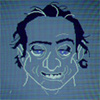

Purpose:
Manage presentational attributes modularly and dynamically
We initially saw this as an identi-kit tool that was interactive, portable, extensible and virtual, allowing police departments to quickly assemble and distribute systematized suspect identification drawings.
File Merging (Library of Design Patterns)
Dynamic Display Controls (Click it. See it.)
Open-Ended Assembly Process (Change anything at any time)
You can "Mix 'n Match" design attributes
Notice the leisurely pace of the drawing of graphics in this video. It's not intentional. This was the default speed for dynamically presentating graphics on the standard "browser" of that time (circa 1985). Early days, but we made it happen.
Potential Applications: Police Identi-kit, Game, Personalized Design Templates
The FaceDancer concept of consistent semantic tags in a flexible design environment was an extension of TCS Textup. It's the conceptual basis of the StyleSwitcher feature.
Fun & Games
Virtual Worlds
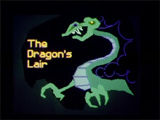

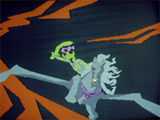
The graphical sophistication and inherent animation of early interactive platforms in the US - lent themselves particularly well to gaming. It was a natural path: Early personal computers (which were often dismissed as "game machines") were accessible and there was already a strong consumer interest in gaming
TCS partner Bill Porter and I were heavily involved in pioneering the interactive online arena. The potential for Massive Multiplayer Online gaming was definitely on our radar early on the curve (1983), even though it would not actually become real until many years later.
"Dragon's Lair", "Minotaur" and "Shadow Warriors" (at right) put sophisticated graphical paint onto the scenario-based, strategic adventure style of RPG interactive game that was popular during the early days of personal computers.
Bill and I also toyed with realtime "first person" shoot'em up type of games, though programming those in within the substantial memory and display limitations of the time was quite a stretch.
Our first venture in that arena was "Bunker" (No images survive, alas). It allowed you to shoot artillery at tanks, which were advancing upon your position. It was simplistic, but challenging: There was a delay between when you aimed & fired and when the shell would land. You needed to anticipate tank speed and path - and the tanks could be tricky.
